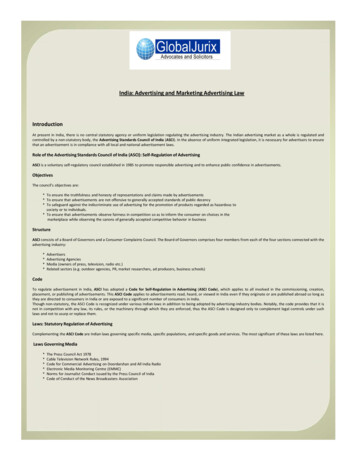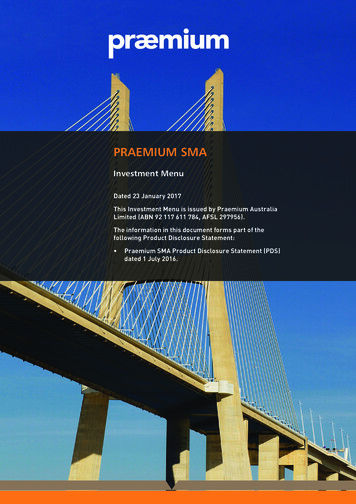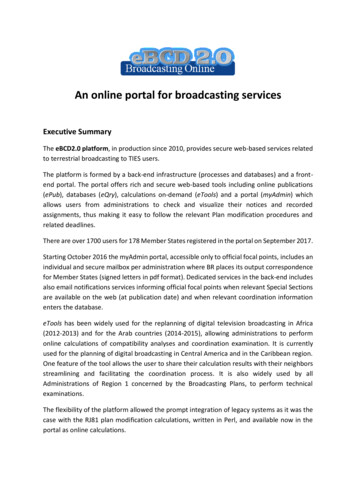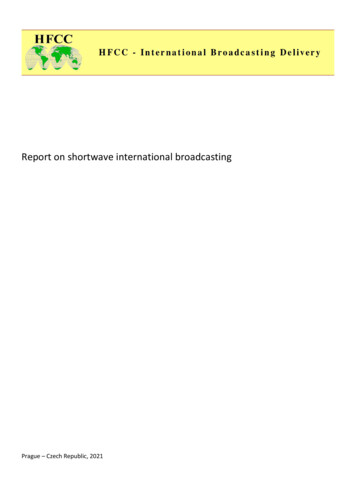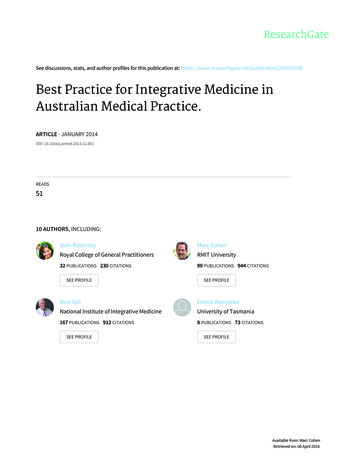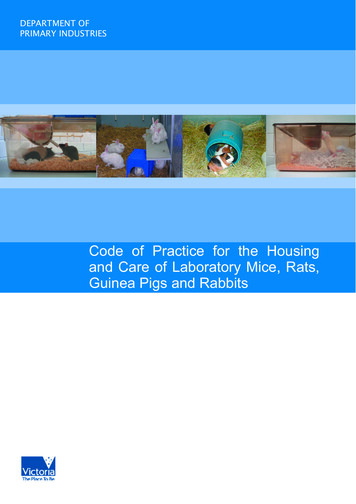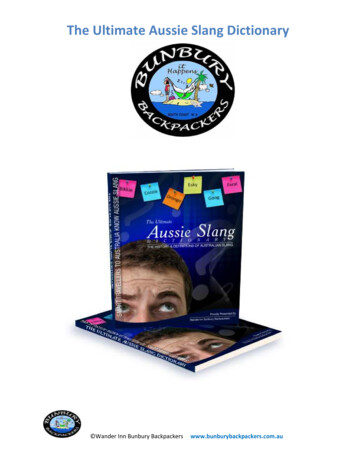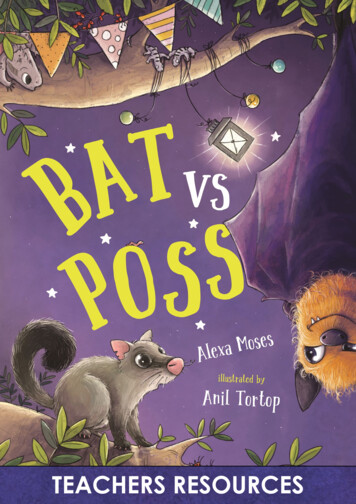
Transcription
CODEOF PRACTICE(& associated standards)January 15, 2019
I. Regulatory FrameworkThe ABC Board is required, under paragraph 8(1)(e) of the ABC Act, to develop a code of practicerelating to its television and radio programming, and to notify this code to the AustralianCommunications and Media Authority (“the ACMA”).A complaint alleging the ABC has acted contrary to its Code of Practice in its television or radioprogramming may be made to the ABC. A complainant is entitled under section 150 of theBroadcasting Services Act 1992 (Cth) (“the BSA”) to take their complaint to the ACMA if, after 60days, the ABC fails to respond to the complainant or the complainant considers the ABC’s response isinadequate.The ACMA has a discretionary power to investigate a complaint alleging the ABC has, in providing anational broadcasting service, breached its Code of Practice. Section 151 of the BSA provides thatthe ACMA may investigate the complaint if it thinks that it is desirable to do so.The ACMA’s jurisdiction under sections 150-151 does not encompass the ABC’s print content orcontent disseminated by the ABC over the internet or through mobile devices.However, the eSafety Commissioner has separate jurisdiction under Schedule 7 to the BSA inrelation to content hosted on websites or transmitted through mobile services where that content iseither “prohibited content”1 or “age-restricted content”2.The eSafety Commissioner is empowered under Schedule 7 to require content service providers andcontent hosts to remove or prevent access to these types of content.The ABC voluntarily complies with the Content Services Code, which is registered as an industry codewith the eSafety Commissioner under clause 85 of Schedule 7 to the BSA.The Content Services Code does not apply to content delivered through online or mobile serviceswhere that content has been previously transmitted on radio or television.Except as expressly provided by the BSA, the regulatory regime established by the BSA does notapply to the ABC: subsection 13(5) of the BSA, and section 79 of the ABC Act.1Prohibited content essentially involves content that is classified either as RC (Refused Classification) orX18 . This includes real depictions of actual sexual activity, child pornography, detailed instruction in crime,and violence or drug use.2Age-restricted content involves content classified as R18 or MA15 that is delivered through a mobiledevice or through a service that provides audio or video content for a fee. This type of content must besubject to a restricted access system, i.e. measures put in place to protect children under the age of 15from exposure to unsuitable material. This category of content includes material containing strong depictionsof nudity, implied sexual activity, drug use or violence, very frequent or very strong coarse language, andother material that is strong in impact.
II. Scope of the CodeThe requirements of this Code are set out in the sections dealing with Interpretation and Standardsin Part IV and the Associated Standard in Part V. The Standards in Part IV apply to radio andtelevision programs broadcast by the ABC on its free-to-air television or radio broadcasting services.The Associated Standard in Part V applies only to television programs broadcast by the ABC on itsdomestic free-to-air television services.Complaints about content on the services named above fall within the scope of the Code exceptwhere: the complaint concerns content which is or becomes the subject of legal proceedings;the complaint was frivolous or vexatious or not made in good faith;the complainant does not have a sufficient interest in the subject matter of the complaint,where the complaint alleges a breach of Fair and honest dealing (Standards 5.1-5.8) or Privacy(Standard 6.1).the complaint was lodged with the ABC more than six weeks after the date when the programwas last broadcast by the ABC on its free-to-air radio or television services, unless the complaintis accepted for investigation on the grounds that is appropriate to do so, having regard to:- the interests of the complainant in the subject matter of the complaint;- the seriousness of the alleged breach;- the reason(s) for the delay;- the availability of the program content which is the subject of the complaint; and- any prejudice the delay may otherwise have on the ability to investigate and determine thematter fairly.III. Resolved ComplaintsThe ABC seeks to comply fully with the Code and to resolve complaints as soon as practicable.A failure to comply will not be a breach of the Code if the ABC has, prior to the complaint beingmade to the ACMA, taken steps which were adequate and appropriate in all the circumstances toredress the cause of the complaint.To illustrate, a failure to comply with Standards 2.1 or 2.2 (Accuracy) will not be taken to be a breachof the Code if a correction or clarification, which is adequate and appropriate in all thecircumstances, is made prior to or within 30 days of the ABC receiving the complaint.
IV. Principles and StandardsPreambleThe ABC belongs to the Australian people.Earning and retaining their trust is essential to fulfilling the ABC’s charter and its responsibilities underthe ABC Act to provide innovative and comprehensive services of a high standard to Australian andinternational audiences.The principles and standards set out below are the means by which the ABC seeks to meet theseobligations.They uphold the fundamental journalistic principles of accuracy and impartiality, to protect the ABC’sindependence and integrity.They recognise that ABC content must be created in a way that is respectful towards audiences andmindful of community standards in areas like harm and offence.At the same time, they recognise that the ABC needs to be adventurous, brave and creative:Adventurous in encouraging new and sometimes confronting forms of art and entertainment.Brave in reporting without fear or favour, even when that might be uncomfortable orunpopular; andCreative in finding new ways of telling Australian stories, reflecting Australian culture andsharing in the Australian conversation.By holding to these principles and standards, the ABC seeks to be accountable to the Australian peoplewho fund us.1. InterpretationIn this Code, the Standards must be interpreted and applied in accordance with the Principlesapplying in each Section. From time to time, the ABC publishes Guidance Notes which do not inthemselves impose obligations on the ABC, but which may be relevant in interpreting and applyingthe Code.The Standards in Parts IV and V are to be interpreted and applied with due regard for the nature ofthe content under consideration in particular cases. The ABC is conscious that its dual obligations –for accountability and for high quality – can in practice interact in complex ways. It can be a sign ofstrength not weakness that journalism enrages or art shocks. The Standards are to be applied inways that maintain independence and integrity, preserve trust and do not unduly constrainjournalistic enquiry or artistic expression.
2. AccuracyPrinciples: The ABC has a statutory duty to ensure that the gathering and presentation of news andinformation is accurate according to the recognised standards of objective journalism. Credibilitydepends heavily on factual accuracy. Types of fact-based content include news and analysis ofcurrent events, documentaries, factual dramas and lifestyle programs. The ABC requires thatreasonable efforts must be made to ensure accuracy in all fact-based content. The ABC gauges thoseefforts by reference to: the type, subject and nature of the content; the likely audience expectations of the content; the likely impact of reliance by the audience on the accuracy of the content; and the circumstances in which the content was made and presented.The ABC accuracy standard applies to assertions of fact, not to expressions of opinion. An opinion,being a value judgement or conclusion, cannot be found to be accurate or inaccurate in the wayfacts can. The accuracy standard requires that opinions be conveyed accurately, in the sense thatquotes should be accurate and any editing should not distort the meaning of the opinion expressed.The efforts reasonably required to ensure accuracy will depend on the circumstances. Sources withrelevant expertise may be relied on more heavily than those without. Eyewitness testimony usuallycarries more weight than second-hand accounts. The passage of time or the inaccessibility oflocations or sources can affect the standard of verification reasonably required.The ABC should make reasonable efforts, appropriate in the context, to signal to audiencesgradations in accuracy, for example by querying interviewees, qualifying bald assertions,supplementing the partly right and correcting the plainly wrong.Standards:2.1 Make reasonable efforts to ensure that material facts are accurate and presented in context.2.2 Do not present factual content in a way that will materially mislead the audience. In some cases,this may require appropriate labels or other explanatory information.3. Corrections and clarificationsPrinciples: A commitment to accuracy includes a willingness to correct errors and clarify ambiguousor otherwise misleading information. Swift correction can reduce harmful reliance on inaccurateinformation, especially given content can be quickly, widely and permanently disseminated.Corrections and clarifications can contribute to achieving fairness and impartiality.Standards:3.1 Acknowledge and correct or clarify, in an appropriate manner as soon as reasonably practicable:a. significant material errors that are readily apparent or have been demonstrated; or
b. information that is likely to significantly and materially mislead.4. Impartiality and diversity of perspectivesPrinciples: The ABC has a statutory duty to ensure that the gathering and presentation of news andinformation is impartial according to the recognised standards of objective journalism.Aiming to equip audiences to make up their own minds is consistent with the public servicecharacter of the ABC. A democratic society depends on diverse sources of reliable information andcontending opinions. A broadcaster operating under statute with public funds is legitimatelyexpected to contribute in ways that may differ from commercial media, which are free to be partialto private interests.Judgements about whether impartiality was achieved in any given circumstances can vary amongindividuals according to their personal and subjective view of any given matter of contention.Acknowledging this fact of life does not change the ABC’s obligation to apply its impartiality standardas objectively as possible. In doing so, the ABC is guided by these hallmarks of impartiality: a balance that follows the weight of evidence; fair treatment; open-mindedness; and opportunities over time for principal relevant perspectives on matters of contention to beexpressed.The ABC aims to present, over time, content that addresses a broad range of subjects from adiversity of perspectives reflecting a diversity of experiences, presented in a diversity of ways from adiversity of sources, including content created by ABC staff, generated by audiences andcommissioned or acquired from external content-makers.Impartiality does not require that every perspective receives equal time, nor that every facet ofevery argument is presented.Assessing the impartiality due in given circumstances requires consideration in context of all relevantfactors including: the type, subject and nature of the content; the circumstances in which the content is made and presented; the likely audience expectations of the content; the degree to which the matter to which the content relates is contentious; the range of principal relevant perspectives on the matter of contention; and the timeframe within which it would be appropriate for the ABC to provide opportunities for theprincipal relevant perspectives to be expressed, having regard to the public importance of thematter of contention and the extent to which it is the subject of current debate.
Standards:4.1 Gather and present news and information with due impartiality.4.2 Present a diversity of perspectives so that, over time, no significant strand of thought or beliefwithin the community is knowingly excluded or disproportionately represented.4.3 Do not state or imply that any perspective is the editorial opinion of the ABC. The ABC takes noeditorial stance other than its commitment to fundamental democratic principles including the ruleof law, freedom of speech and religion, parliamentary democracy and equality of opportunity.4.4 Do not misrepresent any perspective.4.5 Do not unduly favour one perspective over another.5. Fair and honest dealingPrinciples: Fair and honest dealing is essential to maintaining trust with audiences and with thosewho participate in or are otherwise directly affected by ABC content. In rare circumstances,deception or a breach of an undertaking may be justified. Because of the potential damage to trust,deception or breach of an undertaking must be explained openly afterwards unless there arecompelling reasons not to do so.Standards:Dealing with participants5.1 Participants in ABC content should normally be informed of the general nature of theirparticipation.5.2 A refusal to participate will not be overridden without good cause.Opportunity to respond5.3 Where allegations are made about a person or organisation, make reasonable efforts in thecircumstances to provide a fair opportunity to respond.Attribution and sources5.4 Aim to attribute information to its source.5.5 Where a source seeks anonymity, do not agree without first considering the source’s motive andany alternative attributable sources.5.6 Do not misrepresent another’s work as your own.Undertakings5.7 Assurances given in relation to conditions of participation, use of content, confidentiality oranonymity must be honoured except in rare cases where justified in the public interest.Secret recording and other types of deception
5.8 Secret recording, misrepresentation or other types of deception must not be used by the ABC orits co-production partners to obtain or seek information, audio, pictures or an agreement toparticipate except where:(a) justified in the public interest and the material cannot reasonably be obtained by any othermeans; or(b) consent is obtained from the subject or identities are effectively obscured; or(c) the deception is integral to an artistic work.In all cases, the potential for harm must be taken into consideration.6. PrivacyPrinciples: Privacy is necessary to human dignity and every person reasonably expects that theirprivacy will be respected. But privacy is not absolute. The ABC seeks to balance the public interest inrespect for privacy with the public interest in disclosure of information and freedom of expression.Standards:6.1 Intrusion into a person’s private life without consent must be justified in the public interest andthe extent of the intrusion must be limited to what is proportionate in the circumstances.7. Harm and offencePrinciples: The ABC broadcasts comprehensive and innovative content that aims to inform, entertainand educate diverse audiences. This involves a willingness to take risks, invent and experiment withnew ideas. It can result in challenging content which may offend some of the audience some of thetime. But it also contributes to diversity of content in the media and to fulfilling the ABC’s function toencourage and promote the musical, dramatic and other performing arts. The ABC acknowledgesthat a public broadcaster should never gratuitously harm or offend and accordingly any contentwhich is likely to harm or offend must have a clear editorial purpose.The ABC potentially reaches the whole community, so it must take into account communitystandards. However, the community recognises that what is and is not acceptable in ABC contentlargely depends upon the particular context, including the nature of the content, its target audience,and any signposting that equips audiences to make informed choices about what they see, hear orread. Applying the harm and offence standard, therefore, requires careful judgement. What may beinappropriate and unacceptable in one context may be appropriate and acceptable in another.Coarse language, disturbing images or unconventional situations may form a legitimate part ofreportage, debate, documentaries or a humorous, satirical, dramatic or other artistic work.Standards:7.1 Content that is likely to cause harm or offence must be justified by the editorial context.7.2 Where content is likely to cause harm or offence, having regard to the context, make reasonableefforts to provide information about the nature of the content through the use of classificationlabels or other warnings or advice.
7.3 Ensure all domestic television programs – with the exception of news, current affairs andsporting events – are classified and scheduled for broadcast in accordance with the ABC’s AssociatedStandard on Television Program Classification.7.4 If inadvertent or unexpected actions, audio or images in live content are likely to cause harm oroffence, take appropriate steps to mitigate.7.5 The reporting or depiction of violence, tragedy or trauma must be handled with extremesensitivity. Avoid causing undue distress to victims, witnesses or bereaved relatives. Be sensitive tosignificant cultural practices when depicting or reporting on recently deceased persons.7.6 Where there is editorial justification for content which may lead to dangerous imitation orexacerbate serious threats to individual or public health, safety or welfare, take appropriate steps tomitigate those risks, particularly by taking care with how content is expressed or presented.7.7 Avoid the unjustified use of stereotypes or discriminatory content that could reasonably beinterpreted as condoning or encouraging prejudice.8. Children and young peoplePrinciples: The ABC aims to provide children and young people (under the age of 18) with enjoyableand enriching content, as well as opportunities for them to express themselves.Children and young people participate and interact with the ABC in various ways – as actors,presenters, interviewees, subjects, content makers and audience members.The ABC has a responsibility to protect children and young people from potential harm that mightarise during their engagement with the ABC and its content. The ABC shares this responsibility withparents/guardians and with the child or young person him/herself.In particular, the ABC recommends that parents/guardians supervise children and young people’saccess to content, their participation in interactive services, and their exposure to news and currentaffairs. It is not always possible to avoid presenting content that may be distressing to someaudience members.Standards:8.1 Take due care over the dignity and physical and emotional welfare of children and young peoplewho are involved in making, participating in and presenting content produced or commissioned bythe ABC.8.2 Before significant participation of a child or young person in content produced or commissionedby the ABC, or in interactive services offered by the ABC, consider whether it is appropriate to obtainthe consent of both the child/young person and the parent/guardian.8.3 Adopt appropriate measures wherever practicable to enable children and young people, or thosewho supervise them, to manage risks associated with the child/young person’s participation with,use of and exposure to ABC content and services designed for them.
8.4 Take particular care to minimise risks of exposure to unsuitable content or inappropriate contactby peers or strangers.
V. Associated Standard:Television Program ClassificationStatus of Associated StandardThis Associated Standard is approved by the ABC Board and is binding. It is for consideration byrelevant editorial decision-makers when providing advice on compliance and by complaints bodieswhen dealing with complaints. The Associated Standard is provided to assist interpretation of orotherwise supplement the standard in the Editorial Policies to which the Associated Standardrelates.This Associated Standard forms part of the Code of Practice notified to the AustralianCommunications and Media Authority under section 8(1)(e) of the Australian BroadcastingCorporation Act 1983.Key Editorial Standard7.3 Ensure all domestic television programs – with the exception of news, current affairs andsporting events – are classified and scheduled for broadcast in accordance with the ABC’s AssociatedStandard on Television Program Classification.Principles:The ABC applies the classifications listed below to the broadcast of all its domestic televisionprograms with the exception of news, current affairs and sporting events.The ABC classifications are adapted from the Guidelines for the Classification of Films and ComputerGames issued by the Classification Board made under the Classification (Publications, Films andComputer Games) Act 1995.The guiding principle in the application of the following classifications is context. What isinappropriate and unacceptable in one context may be appropriate and acceptable in another.Factors to be taken into account include: the artistic or educational merit of the production, thepurpose of a sequence, the tone, the camera work, the intensity and relevance of the material, thetreatment, and the intended audience.Standards:7.3.1 Television ClassificationsG – GENERALG programs may be shown at any time. G programs, which include programs designed for pre-schooland school-aged children, are suitable for children to watch on their own.Some G programs may be more appropriate for older children.
The G classification does not necessarily indicate that the program is one that children will enjoy.Some G programs contain themes or storylines that are not of interest to children.Whether or not the program is intended for children, the treatment of themes and other classifiableelements will be careful and discreet.Themes: The treatment of themes should be discreet, justified by context, and very mild in impact.The presentation of dangerous, imitable behaviour is not permitted except in those circumstanceswhere it is justified by context. Any depiction of such behaviour must not encourage dangerousimitation.Violence: Violence may be very discreetly implied, but should: have a light tone, or have a very low sense of threat or menace, and be infrequent, and not be gratuitous.Sex: Sexual activity should: only be suggested in very discreet visual or verbal references, and be infrequent, and not be gratuitous.Artistic or cultural depictions of nudity in a sexual context may be permitted if the treatment isdiscreet, justified by context, and very mild in impact.Language: Coarse language should: be very mild and infrequent, and not be gratuitous.Drug Use: The depiction of the use of legal drugs should be handled with care. Illegal drug use shouldbe implied only very discreetly and be justified by context.Nudity: Nudity outside of a sexual context should be: infrequent, and not detailed, and not gratuitous.PG – PARENTAL GUIDANCE(Parental Guidance recommended for people under 15 years)
Subject to the Implementation Guidelines at 7.3.2, PG programs may be shown in accordance withTime Zone Charts at 7.3.5.PG programs may contain themes and concepts which, when viewed by those under 15 years, mayrequire the guidance of an adult. The PG classification signals to parents that material in thiscategory contains depictions or references which could be confusing or upsetting to children withoutadult guidance. Material classified PG will not be harmful or disturbing to children.Parents may choose to preview the material for their children. Some may choose to watch thematerial with their children. Others might find it sufficient to be accessible during or after theviewing to discuss the content.Themes: The treatment of themes should be discreet and mild in impact. More disturbing themesare not generally dealt with at PG level. Supernatural or mild horror themes may be included.Violence: Violence may be discreetly implied or stylised and should also be: mild in impact, and not shown in detail.Sex: Sexual activity and nudity in a sexual context may be suggested, but should: be discreet, and be infrequent, and not be gratuitous.Verbal references to sexual activity should be discreet.Language: Coarse language should be mild and infrequent.Drug Use: Discreet verbal references and mild, incidental visuals of drug use may be included, butthese should not promote or encourage drug use.Nudity: Nudity outside of a sexual context should not be detailed or gratuitous.M – MATURE(Recommended for people aged 15 years and over)Subject to the Implementation Guidelines at 7.3.2, M programs may be shown in accordance withthe Time Zone Charts at 7.3.5.The M category is recommended for people aged over 15 years. Programs classified M containmaterial that is considered to be potentially harmful or disturbing to those under 15 years.Depictions and references to classifiable elements may contain detail.While most themes may be dealt with, the degree of explicitness and intensity of treatment willdetermine what can be accommodated in the M category – the less explicit or less intense material
will be included in the M classification and the more explicit or more intense material, especiallyviolent material, will be included in the MA15 classification.Themes: Most themes can be dealt with, but the treatment should be discreet and the impactshould not be strong.Violence: Generally, depictions of violence should: not contain a lot of detail, and not be prolonged.In realistic treatments, depictions of violence that contain detail should: be infrequent, and not have a strong impact, and not be gratuitous.In stylised treatments, depictions of violence may contain more detail and be more frequent if thisdoes not increase the impact.Verbal and visual references to sexual violence may only be included if they are: discreet and infrequent, and strongly justified by the narrative or documentary context.Sex: Sexual activity may be discreetly implied.Nudity in a sexual context should not contain a lot of detail or be prolonged.Verbal references to sexual activity may be more detailed than depictions if this does not increasethe impact.Language: Coarse language may be used.Generally, coarse language that is stronger, detailed or very aggressive should: be infrequent, and not be gratuitous.Drug Use: Drug use may be discreetly shown.Drug use should not be promoted or encouraged.Nudity: Nudity outside of a sexual context may be shown but depictions that contain any detailshould not be gratuitous.MA15 – MATURE AUDIENCE
(Not suitable for people under 15 years)Subject to the Implementation Guidelines at 7.3.2, MA15 programs may be shown in accordancewith the Time Zone Charts at 7.3.5.MA15 programs, because of the matter they contain or because of the way it is treated, are notsuitable for people aged under 15 years.Material classified MA15 deals with issues or contains depictions which require a more matureperspective. This is because the impact of individual elements or a combination of elements isconsidered likely to be harmful or disturbing to viewers under 15 years of age. While most themesmay be dealt with, the degree of explicitness and intensity of treatment will determine what can beaccommodated in the MA15 category – the more explicit or more intense material, especiallyviolent material, will be included in the MA15 classification and the less explicit or less intensematerial will be included in the M classification.Themes: The treatment of themes with a high degree of intensity should not be gratuitous.Violence: Generally, depictions of violence should not have a high impact.In realistic treatments, detailed depictions of violence with a strong impact should: be infrequent, and not be prolonged, and not be gratuitous.Depictions of violence in stylised treatments may be more detailed and more frequent if this doesnot increase the impact.Depictions of sexual violence are permitted only if they are not frequent, prolonged, gratuitous orexploitative.Sex: Sexual activity may be implied.Depictions of nudity in a sexual context which contain detail should not be exploitative.Verbal references may be more detailed than depictions if this does not increase the impact.Language: Coarse language may be used.Coarse language that is very strong, aggressive or detailed should not be gratuitous.Drug Use: Drug use may be shown but should not be promoted or encouraged.More detailed depictions should not have a high degree of impact.Nudity: Nudity should be justified by context.7.3.2 Implementation Guidelines
The time zones for each program classification are guides to the most likely placement of programswithin that classification. They are not hard and fast rules and there will be occasions on whichprograms or segments of programs appear in other time zones.There must be sound reasons for any departure from the time zone for a program classification.Possible reasons might include, for example, the need to schedule programs which are seriouspresentations of moral, social or cultural issues, in timeslots most suitable for their target audiences.Programs, including those having a particular classification under the Classification Board’sGuidelines for the Classification of Films and Computer Games, may be modified so that they aresuitable for broadcast or suitable for broadcast at particular times.Broken Hill in New South Wales shares a time zone with South Australia but ordinarily receives theABC’s New South Wales TV services. Given the time zone difference, some progr
The ABC Board is required, under paragraph 8(1)(e) of the ABC Act, to develop a code of practice relating to its television and radio programming, and to notify this code to the Australian ommunications and Media Authority ("the AMA"). A complaint alleging the ABC has acted contrary to its Code of Practice in its television or radio programming may be made to the ABC. A complainant is .
